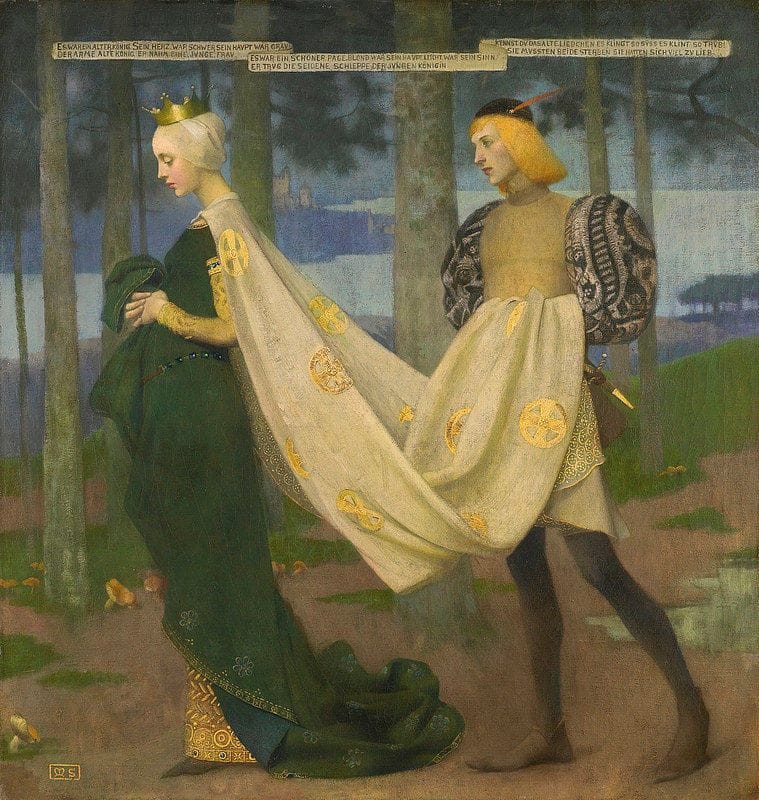

The Queen and the Page,
Marianne Stokes
In the 1890s the Austrian-born Marianne Stokes (neé Priendelsberger) was drawn to romances from European folklore and literature for inspiration.
he quotation inscribed upon the painting is from the 1844 German poem by Heinrich Heine's There Once was a King which told of the fated love of a page for his mistress and her reciprocal love for him. The painting was described as ‘…an imaginative work of great power and beauty, depicting the story of Heine’s poems. The lady is walking through the fair grounds of the palace pleasaunce – her train carried by her attendant and lover. Both are in sumptuous attire, and one hardly knows which to admire the more – the magnificent gold brocading of the Queen’s robes or the exquisite embroidery of the page’s dress. Highly decorative in scheme – charming in colour and elaborate in detail.’ (St Ives Weekly Summary, 11 April 1896) The art critic Wilfrid Meynell wrote of the picture; ‘… In the grêle lady the artist has drawn a clear round-browed Piero della Francesca profile with delicately hollow eyes, expressive of some threat of evil destiny. The feeling in the design of the figure has sweetness and distinction…’ (quoted by Magdalen Evans, Utmost Fidelity, 2009, p.64)
...in 1897, The Queen and the Page was singled-out for praise; ‘In another picture by Mrs A.S., which hangs in Mr McCulloch’s gallery, we are taken at one step from fact to fiction, from a world of realism to another where fancy reigned. The Page, this second canvas, in no way pretends to record any phase of the life about us. It is purely imaginative, a pretty phantasy treated in the spirit of medieval romance and in feeling and manner akin to the quaint tapestry designed, with the execution of which in bygone centuries great dames occupied their many hours of leisure. This technical character is the outcome of the convention which the artist has adopted in dealing with her subject, a convention based chiefly upon decorative essentials, and disregarding almost entirely the possibilities of realism. The background, against which the figures are relieved, is a landscape indeed, but the trees, the sea, and the distant hills, which are combined to make it up, are treated simply as flat colour surfaces, filling important colour spaces, and by their arrangement providing a pleasant pattern of lines and hues. The figures themselves are in quite consistent with the medieval atmosphere of the picture. In dress, manner and appearance they have litter to connect them with the present day. The pale, wan page with his spare figure and somewhat sorrowful cast of countenance, and the demure princess with her close fitting robe and golden crown, are drawn from a fairy-tale world untroubled by modern thoughts and ways. The artist has made something of a contrast between the two faces, between the expression of hopeless devotion which is worn by the lad, and quiet unconsciousness of the maiden whose train he bears; but the contrast is purely a poetic one, and is not accentuated by the melodramatic touch.’ (A.L.Baldry, ‘The Collection of George McCulloch Esq.’, The Art Journal, 1897, p.72). (http://www.sothebys.com/en/auctions/ecatalogue/2014/victorian-pre-raphaelite-british-impressionist-art-l15132/lot.27.html)
40 x 38 in
Uploaded on Aug 1, 2016 by Suzan Hamer
Marianne Stokes
artistArthur
Wait what?